Introduction
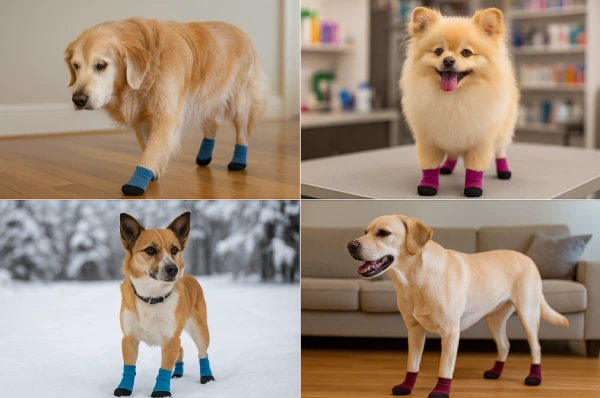
Not all dog socks grip alike—what works on tile may flop on hardwood. If you’ve ever watched your pup skid across a glossy floor like a cartoon character, you already know traction matters. But the real question is: what kind of grip pattern actually works best for your dog and your home?
In the world of non-slip dog socks, three major traction styles dominate:
- Rubber dots (small silicone or rubber patches arranged on the sock sole)
- All-around coatings (a full 360° rubber or silicone wrap around the paw)
- Dual-side prints (grips on both the bottom and top of the sock)
Each design has strengths and trade-offs. The trick is matching the right grip style to your dog’s weight, stride, and the surfaces in your home. Floors vary—hardwood, tile, and laminate each interact differently with grip materials.
Pattern Coverage vs. Twist Risk
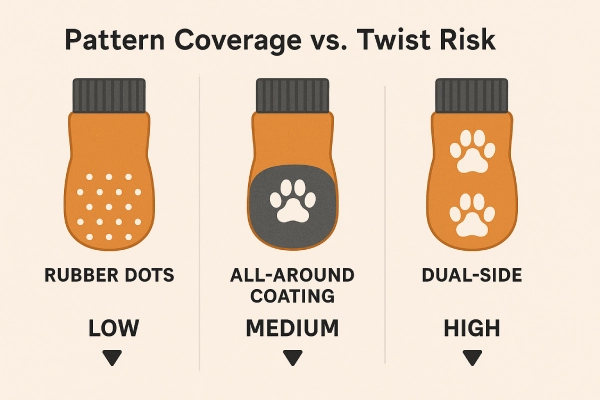
Rubber Dots: Lightweight but Limited
The classic dog sock features small silicone or rubber dots printed across the paw area. These dots create contact points for friction, giving a dog more traction than bare paws. On textured laminate or rough tile, they work surprisingly well.
But the flaw is coverage. If the sock twists around the paw—a common occurrence on polished hardwood—those dots may rotate up the side, leaving a slick fabric bottom on the floor. Light dogs often get away with it; heavy dogs, less so.
All-Around Coatings: Total Coverage
All-around coatings wrap the lower portion of the sock in a continuous rubber or silicone layer, almost like a dipped glove for paws. The result: 360° grip. Even if the sock spins, traction remains underfoot. This makes them the gold standard for slippery hardwood or glossy tile.
The trade-off is breathability. Full coatings are less flexible, trap more heat, and can feel bulky to sensitive dogs. Still, for large breeds or dogs with serious mobility issues, reliability outweighs comfort.
Dual-Side Prints: The Middle Ground
Dual-sided socks have a grip printed on both the top and bottom of the paw. If the sock rotates, there’s still traction—though only in two planes, not all around. For many medium-sized dogs, this “two-way safety net” is enough.
They’re lighter and more breathable than full coatings, but sturdier than single-dot designs. Think of them as the compromise option: good grip without the rubber “boot” feel.
Thick vs. Thin Coatings: Grip Strength vs. Flexibility
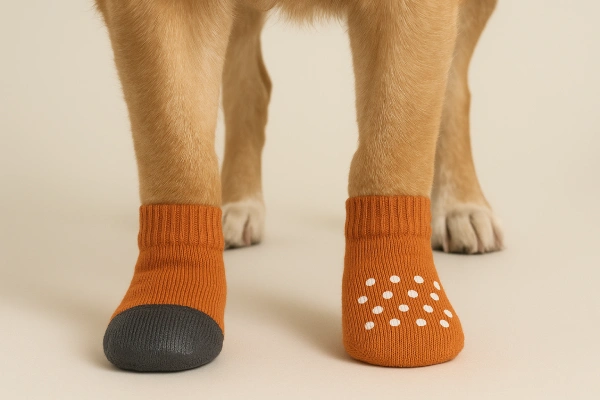
Not all rubber is created equal. Thickness and distribution affect both traction and comfort.
Thick All-Around Coatings
- Deliver maximum friction and durability.
- Provide a “tire tread” feel for heavy dogs on slippery floors.
- The catch: thickness reduces flexibility, which can feel bulky. Paws may also overheat since airflow is limited.
Thin Dots or Silicone Prints
- Offer lightweight flexibility and breathability.
- Dogs feel the floor through the sock, which helps with natural balance.
- Downside: thin dots can wear smooth after repeated use, especially under larger dogs. They also struggle on mirror-slick surfaces like polished marble or glassy tile.
Dual-Side Prints
- Best for mid-size dogs on moderately slippery floors.
- Usually medium thickness, striking a balance between comfort and grip.
- Still breathable, but it offers more security than single-dot layouts.
Comfort Trade-Offs: Daily Wear of Dog Grip Socks
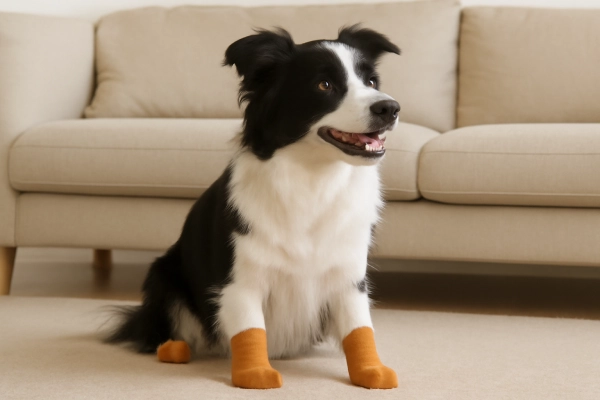
A traction sock should not only grip but also feel comfortable for daily wear. Otherwise, your dog will fight to get them off.
Paw Feedback
Dogs rely on paw sensitivity for balance. Thick coatings dull that tactile sense, which can feel odd to some dogs. Dotted socks preserve paw “feel,” helping dogs adapt faster.
Long-Wear Issues
Rubber-heavy socks can cause moisture build-up, which in turn may irritate skin or nails. Dots and dual-sided prints breathe better but wear out quicker. If daily wear is your plan, rotating multiple pairs is smart.
Breathability & Temperature
Cotton socks with silicone dots are airy and suitable for long hours indoors. In contrast, all-around rubber shells trap heat and moisture—fine for short bursts, less so for all-day use.
Recommended Patterns by Dog Weight and Floor Type
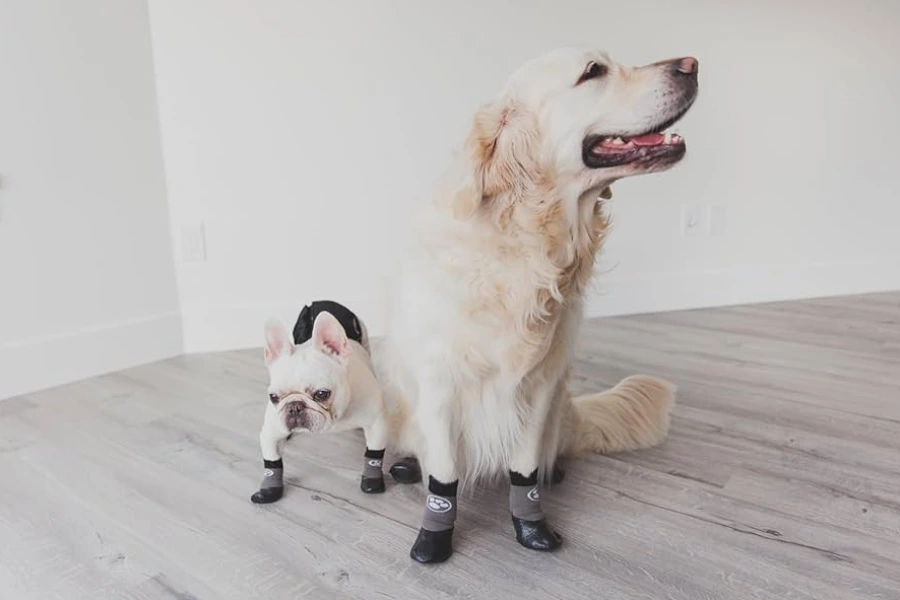
Different dogs, different needs—and that starts with knowing their paw size and shape. Measuring width, splay, and even the difference between front and back paws makes all the difference (our [step-by-step paw measuring guide](The Science of Fit: Measuring Dog Paws Like a Pro) can help). A Yorkie on laminate has completely different traction requirements than a Mastiff on polished oak.
Lightweight Dogs (<15 lbs):
- Often fine with simple silicone dot socks. Their lightweight means less slippage pressure and less sock twisting.
- Best on laminate or textured tile floors.
Medium Dogs (15–50 lbs):
- Dual-sided prints shine here. They balance breathability with twist protection, giving stability on smooth hardwood or semi-gloss tile.
- Dogs in this weight class are active enough to twist socks, but not so heavy that only all-around coatings will do.
Large/Giant Breeds (50+ lbs):
- Heavy bodies mean heavier paw strikes. All-around coatings are the safest bet—anything less risks quick wear or slippage.
- Ideal for hardwood and glossy tile, where the sheer force of weight needs maximum friction.
Floor-Specific Tips:
- Hardwood: All-around or dual-sided patterns work best to prevent spin-outs.
- Tile: All-around grip for polished tile; dots are acceptable on textured ceramic.
- Laminate: Dual-sided socks offer the best mix of grip and comfort.
Quick Comparison Chart
| Pattern Type | Light Dogs (<15 lbs) | Medium Dogs (15–50 lbs) | Large/Giant Dogs (50+ lbs) | Best Floor Match | Watch-outs |
|---|---|---|---|---|---|
| Rubber Dots | ✅ Stable; lightweight paws rarely twist. | ⚠️ Adequate but may rotate. | ❌ Too weak under heavy pressure. | Textured tile, laminate | Spin risk on polished hardwood. |
| Dual-Side Prints | ✅ Extra insurance if socks twist. | ✅ Best balance of grip + comfort. | ⚠️ May slip under very heavy dogs. | Laminate, hardwood | Side gaps leave small slick zones. |
| All-Around Coatings | ⚠️ Overkill—can feel stiff. | ✅ Strong and reliable indoors. | ✅✅ Ideal; maximum stability. | Hardwood, glossy tile | Less breathable; bulkier fit. |
FAQ: Dog Grip Socks and Anti-Slip Solutions
Do non-slip dog socks work?
Yes, non-slip dog socks really work when chosen in the right size and design. They add traction with silicone dots, dual-side prints, or full rubber coatings that prevent paws from sliding on hardwood, tile, or laminate floors. For senior dogs or those with arthritis, these socks provide extra stability and confidence while walking indoors.
How do I stop my dog’s feet from slipping?
The most effective way is to use dog traction socks or paw protectors designed with non-slip grips. Trimming your dog’s nails and paw hair also helps improve natural traction. For extra slippery surfaces like glossy tile, all-around coated socks or dog boots with rubber soles work best.
What are the socks that dogs wear to stop slipping?
They are called non-slip dog socks or dog grip socks. These socks usually feature rubber dots, dual-sided silicone prints, or all-around coatings that create friction between the paw and the floor. Some brands also add Velcro straps to ensure the socks stay in place during movement.
What pads stop dogs from slipping?
There are two main types:
- Rubber traction pads built into non-slip dog socks, which cover the paw and stop sliding.
- Adhesive paw pads or “paw grips” that stick directly onto the dog’s paw pads. Both methods improve traction, but socks provide added benefits like protecting hardwood floors from scratches and keeping paws clean.
Do toe grips for dogs actually work?
Yes, dog toe grips can help, especially for senior dogs with arthritis or mobility issues. They are small rubber rings that slip over the nails and add extra traction on smooth surfaces. However, toe grips don’t protect floors or paws like socks do, so many owners use them as a supplement rather than a replacement for non-slip dog socks.
Conclusion: Matching Pattern to Paw & Floor
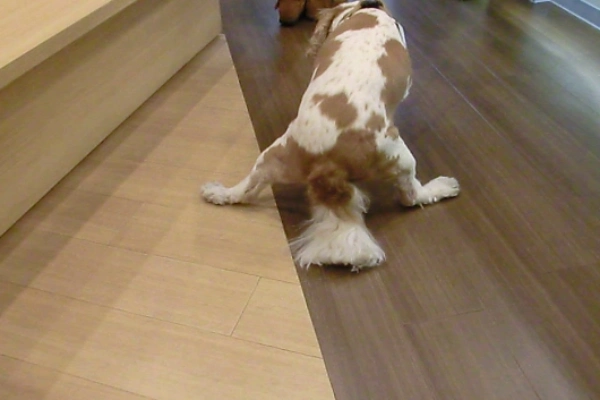
When it comes to dog grip socks, the “best” pattern isn’t universal. Rubber dots excel for light dogs on mild surfaces. Dual-sided prints are the versatile middle choice for medium dogs and mixed floors. All-around coatings are the power option for big dogs and ultra-slippery hardwood or tile.
The key is to match the traction pattern not just to your floor, but also to your dog’s size and gait. A five-pound Chihuahua and a ninety-pound Labrador simply won’t succeed with the same sock design. By choosing wisely, you’ll keep your dog upright, confident, and safe while sparing your floors from scratches.
Looking for customized designs or bulk dog grip sock orders? Max Hosiery specializes in high-quality traction socks tailored for both pets and retailers—contact us today to explore samples and flexible purchasing options.
